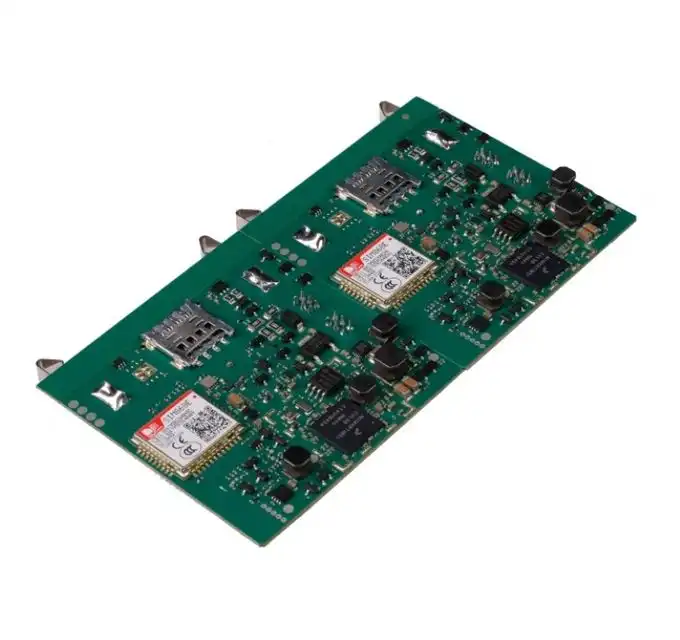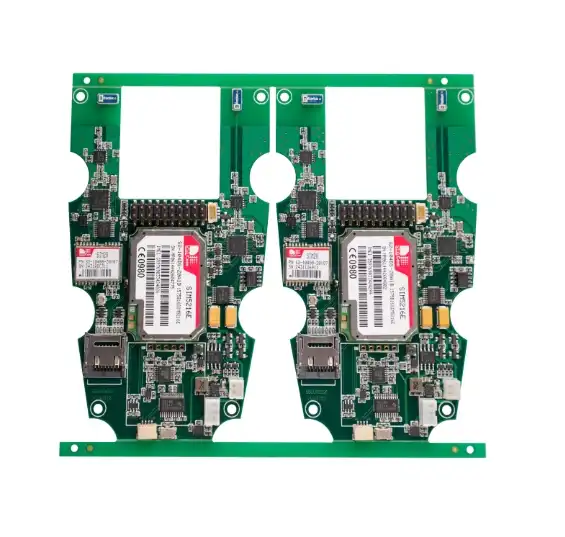Introducing Impedance in High-Frequency PCBs
High-frequency PCBs operate in a realm where every design decision can have a profound impact on signal integrity and overall performance. At the heart of this challenge lies impedance control – a critical factor that can make or break a high-frequency circuit design.
What is Impedance in PCB Design?
Impedance in PCB design refers to the opposition a circuit presents to the flow of alternating current (AC). In high-frequency applications, this becomes particularly important as it affects how signals propagate through the board. Essentially, impedance is a complex combination of resistance, capacitance, and inductance that varies with frequency.
For high-frequency PCBs, maintaining consistent impedance throughout the signal path is crucial. Any sudden changes in impedance can lead to signal reflections, which in turn cause distortions, losses, and potentially, failure of the entire system. This is why impedance control is a cornerstone of high-frequency PCB design and manufacturing.
The Importance of Impedance Control in High-Frequency Applications
In high-frequency applications, such as those found in telecommunications, aerospace, and advanced computing systems, the need for precise impedance control becomes even more pronounced. As frequencies increase, the wavelength of the signals decreases, making them more susceptible to distortions caused by impedance mismatches.
Proper impedance control ensures:
- Minimal signal reflections, reducing noise and improving signal integrity
- Optimal power transfer between components
- Reduced electromagnetic interference (EMI)
- Improved overall system reliability and performance
Without effective impedance control, high-frequency PCBs may suffer from issues like crosstalk, signal attenuation, and increased power consumption. These problems can lead to decreased performance, reliability issues, and in some cases, complete system failure.
Factors Affecting Impedance in High-Frequency PCBs
Several factors come into play when considering impedance in high-frequency PCB design:
- Trace width and thickness
- Dielectric material properties (especially the dielectric constant)
- Stackup design and layer thicknesses
- Proximity to ground and power planes
- Presence of vias and other discontinuities
- Surface finish
Each of these factors can significantly influence the impedance characteristics of a PCB. For instance, a change in trace width or dielectric thickness can alter the capacitance and inductance of the transmission line, directly affecting its impedance. Similarly, the choice of dielectric material can impact signal propagation speeds and losses.
Key Strategies for Impedance Control in High-Frequency PCB Manufacturing
Controlling impedance in high-frequency PCB manufacturing requires a multifaceted approach. By implementing key strategies, manufacturers can ensure that the final product meets the stringent requirements of high-frequency applications. Let's explore these strategies in detail.
Precise Material Selection
The choice of materials plays a pivotal role in impedance control for high-frequency PCBs. The dielectric material, in particular, has a significant impact on the board's electrical characteristics.
- Dielectric Material Selection: High-frequency PCBs often use specialized materials with low dielectric constants (Dk) and low dissipation factors (Df). Materials like Rogers RO4350B or Taconic RF-35 are popular choices due to their excellent electrical properties and stability across a wide range of frequencies.
- Copper Foil Considerations: The type and quality of copper foil used can affect impedance control. Reverse-treated foils or very low-profile (VLP) copper can help achieve more precise and consistent trace geometries, crucial for maintaining impedance.
- Material Consistency: Ensuring consistency in material properties across the entire board and between different production batches is crucial. Even small variations can lead to impedance mismatches.
Careful Stackup Design
The PCB stackup design is a critical factor in controlling impedance, especially for multi-layer boards.
- Layer Arrangement: Carefully planning the arrangement of signal, ground, and power layers can help maintain consistent impedance. For instance, stripline configurations (where the signal layer is sandwiched between two ground planes) offer excellent impedance control and signal isolation.
- Layer Thicknesses: Precise control over the thickness of each layer, especially the dielectric layers, is essential. Even small variations can significantly impact impedance.
- Symmetry: A symmetrical stackup design can help minimize warpage and maintain consistent impedance across the board.
Controlled Trace Geometry
The geometry of the signal traces is a key factor in determining impedance.
- Trace Width and Spacing: Precise control over trace width and spacing is crucial. For high-frequency applications, narrower traces with tighter tolerances are often required.
- Trace Routing: Avoiding sharp corners and maintaining consistent trace widths throughout the signal path helps maintain uniform impedance. The use of curved traces or mitered corners can help reduce reflections at bends.
- Differential Pair Design: For differential signaling, maintaining consistent spacing and length matching between the pairs is critical for impedance control.
Advanced Fabrication Techniques
Manufacturing high-frequency PCBs with controlled impedance requires specialized fabrication techniques.
- Precise Etching: Advanced etching techniques, such as laser direct imaging (LDI), can achieve more precise and consistent trace geometries compared to traditional methods.
- Controlled Prepreg Pressing: Careful control of pressure and temperature during lamination helps maintain consistent dielectric thicknesses, crucial for impedance control.
- Impedance Testing: In-process and final impedance testing using time-domain reflectometry (TDR) or vector network analyzers (VNA) ensures that the manufactured board meets the specified impedance requirements.
By implementing these strategies, PCB manufacturers can effectively control impedance in high-frequency boards. This level of control is essential for producing reliable, high-performance PCBs capable of meeting the demanding requirements of modern high-frequency applications.
Challenges and Solutions in High-Frequency PCB Impedance Control
While the strategies discussed earlier form the foundation of effective impedance control in high-frequency PCB manufacturing, several challenges still persist. Understanding these challenges and implementing appropriate solutions is crucial for achieving optimal results.
Material Variability and Environmental Factors
Challenge: Dielectric materials can exhibit variations in their properties due to manufacturing tolerances, temperature fluctuations, and humidity changes. These variations can lead to inconsistencies in impedance across the board or between different production batches.
Solution:
- Use high-quality, tightly specified materials designed for high-frequency applications.
- Implement strict environmental controls during manufacturing and storage.
- Conduct regular material characterization and adjust designs accordingly.
- Consider using temperature and humidity-resistant materials for critical applications.
Dealing with High-Density Interconnects (HDI)
Challenge: As PCB designs become more complex and compact, the use of HDI techniques like microvias and blind/buried vias becomes necessary. However, these features can introduce impedance discontinuities and affect signal integrity.
Solution:
- Carefully model and simulate the impact of vias on impedance using advanced electromagnetic simulation tools.
- Use back-drilling techniques to remove unused portions of vias, reducing their impact on impedance.
- Implement via stitching and proper ground return paths to maintain consistent impedance around vias.
- Consider using laser-drilled microvias for improved precision in high-frequency applications.
Managing Signal Transitions and Connectors
Challenge: Transitions between different transmission line structures (e.g., microstrip to stripline) and connections to external components can create impedance discontinuities, leading to signal reflections and degradation.
Solution:
- Design gradual transitions between different transmission line structures to minimize abrupt changes in impedance.
- Use 3D electromagnetic simulations to optimize connector interfaces and transitions.
- Implement impedance matching techniques at board edges and connector interfaces.
- Consider using high-frequency optimized connectors and careful PCB layout around connector areas.
Balancing Cost and Performance
Challenge: Implementing stringent impedance control measures can significantly increase manufacturing costs, potentially making the final product less competitive in the market.
Solution:
- Prioritize impedance control for critical signal paths while relaxing requirements for less sensitive areas.
- Collaborate closely with PCB manufacturers to optimize designs for manufacturability without compromising performance.
- Leverage advanced design for manufacturing (DFM) tools to identify cost-effective solutions early in the design process.
- Consider using hybrid stackups that combine high-performance materials for critical layers with standard materials for non-critical layers.

Conclusion
Controlling impedance in high-frequency PCB manufacturing is a complex yet crucial process that demands meticulous attention to detail and a comprehensive understanding of various factors. From precise material selection and careful stackup design to controlled trace geometry and advanced fabrication techniques, each aspect plays a vital role in achieving the desired impedance characteristics.
The challenges in this field, such as material variability, dealing with high-density interconnects, managing signal transitions, and balancing cost with performance, require innovative solutions and continuous improvement in manufacturing processes. By addressing these challenges head-on, PCB manufacturers can produce high-quality, high-frequency boards that meet the exacting standards of modern electronic systems.
For businesses seeking reliable high-frequency PCB suppliers and manufacturers, it's crucial to partner with experienced firms that demonstrate a deep understanding of impedance control techniques and have a proven track record in producing high-quality, high-frequency PCBs. Such partnerships can significantly enhance product performance and reliability, ultimately leading to successful and innovative electronic designs.
FAQs
Why is impedance control important in high-frequency PCBs?
Impedance control is crucial in high-frequency PCBs to maintain signal integrity, reduce reflections, and ensure efficient power transmission. It's essential for optimal performance in high-speed digital circuits and RF applications.
What materials are commonly used for high-frequency PCBs?
High-frequency PCBs often use specialized materials with low dielectric constants and low dissipation factors, such as Rogers RO4350B or Taconic RF-35.
How does stackup design affect impedance control?
Stackup design influences impedance by determining the arrangement of signal, ground, and power layers, as well as the thickness of dielectric layers. A carefully designed stackup helps maintain consistent impedance across the board.
Expert High-Frequency PCB Manufacturing Solutions | Ring PCB
At Ring PCB, we specialize in delivering high-quality, high-frequency PCB manufacturing solutions tailored to your specific needs. Our expert team combines advanced fabrication techniques with rigorous quality control to ensure optimal impedance control in every board. From PCB fabrication to full turnkey assembly, we offer comprehensive services to bring your high-frequency designs to life. Experience the difference of working with a trusted PCB manufacturer. Contact us at [email protected] to discuss your high-frequency PCB requirements and discover how our expertise can elevate your next project.
References
1. Johnson, H. and Graham, M. (2003). High-Speed Digital Design: A Handbook of Black Magic. Prentice Hall.
2. Ritchey, L. W. and Zasio, J. (2005). Right the First Time: A Practical Handbook on High-Speed PCB and System Design. Speeding Edge.
3. IPC-2141A (2004). Controlled Impedance Circuit Boards and High-Speed Logic Design. IPC.
4. Bogatin, E. (2018). Signal and Power Integrity - Simplified. Prentice Hall.
5. Hall, S. H. and Heck, H. L. (2009). Advanced Signal Integrity for High-Speed Digital Designs. Wiley-IEEE Press.






